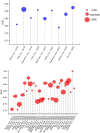A systematic review of machine learning models for management, prediction and classification of ARDS
- PMID: 38834976
- PMCID: PMC11151485
- DOI: 10.1186/s12931-024-02834-x
A systematic review of machine learning models for management, prediction and classification of ARDS
Abstract
Aim: Acute respiratory distress syndrome or ARDS is an acute, severe form of respiratory failure characterised by poor oxygenation and bilateral pulmonary infiltrates. Advancements in signal processing and machine learning have led to promising solutions for classification, event detection and predictive models in the management of ARDS.
Method: In this review, we provide systematic description of different studies in the application of Machine Learning (ML) and artificial intelligence for management, prediction, and classification of ARDS. We searched the following databases: Google Scholar, PubMed, and EBSCO from 2009 to 2023. A total of 243 studies was screened, in which, 52 studies were included for review and analysis. We integrated knowledge of previous work providing the state of art and overview of explainable decision models in machine learning and have identified areas for future research.
Results: Gradient boosting is the most common and successful method utilised in 12 (23.1%) of the studies. Due to limitation of data size available, neural network and its variation is used by only 8 (15.4%) studies. Whilst all studies used cross validating technique or separated database for validation, only 1 study validated the model with clinician input. Explainability methods were presented in 15 (28.8%) of studies with the most common method is feature importance which used 14 times.
Conclusion: For databases of 5000 or fewer samples, extreme gradient boosting has the highest probability of success. A large, multi-region, multi centre database is required to reduce bias and take advantage of neural network method. A framework for validating with and explaining ML model to clinicians involved in the management of ARDS would be very helpful for development and deployment of the ML model.
Keywords: AI; ARDS; Explainable AI.
© 2024. The Author(s).
Conflict of interest statement
The authors declare no conflicts of interest.
Figures






Similar articles
-
Developing and evaluating a machine-learning-based algorithm to predict the incidence and severity of ARDS with continuous non-invasive parameters from ordinary monitors and ventilators.Comput Methods Programs Biomed. 2023 Mar;230:107328. doi: 10.1016/j.cmpb.2022.107328. Epub 2022 Dec 29. Comput Methods Programs Biomed. 2023. PMID: 36640602
-
Machine learning-based prediction model of acute kidney injury in patients with acute respiratory distress syndrome.BMC Pulm Med. 2023 Oct 3;23(1):370. doi: 10.1186/s12890-023-02663-6. BMC Pulm Med. 2023. PMID: 37789305 Free PMC article.
-
Machine learning-based model for predicting the occurrence and mortality of nonpulmonary sepsis-associated ARDS.Sci Rep. 2024 Nov 15;14(1):28240. doi: 10.1038/s41598-024-79899-7. Sci Rep. 2024. PMID: 39548234 Free PMC article.
-
Analytics with artificial intelligence to advance the treatment of acute respiratory distress syndrome.J Evid Based Med. 2020 Nov;13(4):301-312. doi: 10.1111/jebm.12418. Epub 2020 Nov 13. J Evid Based Med. 2020. PMID: 33185950 Review.
-
Machine Learning Tools for Acute Respiratory Distress Syndrome Detection and Prediction.Crit Care Med. 2024 Nov 1;52(11):1768-1780. doi: 10.1097/CCM.0000000000006390. Epub 2024 Aug 12. Crit Care Med. 2024. PMID: 39133071 Review.
Cited by
-
Accuracy of artificial intelligence algorithms in predicting acute respiratory distress syndrome: a systematic review and meta-analysis.BMC Med Inform Decis Mak. 2025 Jan 28;25(1):44. doi: 10.1186/s12911-025-02869-0. BMC Med Inform Decis Mak. 2025. PMID: 39875868 Free PMC article.
-
[Acute respiratory distress syndrome-quo vadis : Innovative and individualized treatment approaches].Med Klin Intensivmed Notfmed. 2025 Jun;120(5):379-388. doi: 10.1007/s00063-025-01273-w. Epub 2025 Apr 22. Med Klin Intensivmed Notfmed. 2025. PMID: 40261329 Free PMC article. Review. German.
-
Comparison of artificial intelligence and logistic regression models for mortality prediction in acute respiratory distress syndrome: a systematic review and meta-analysis.Intensive Care Med Exp. 2025 Feb 21;13(1):23. doi: 10.1186/s40635-024-00706-8. Intensive Care Med Exp. 2025. PMID: 39982531 Free PMC article. Review.
-
Generation of short-term follow-up chest CT images using a latent diffusion model in COVID-19.Jpn J Radiol. 2025 Apr;43(4):622-633. doi: 10.1007/s11604-024-01699-w. Epub 2024 Nov 25. Jpn J Radiol. 2025. PMID: 39585556 Free PMC article.
-
Predictive Modeling of Acute Respiratory Distress Syndrome Using Machine Learning: Systematic Review and Meta-Analysis.J Med Internet Res. 2025 May 13;27:e66615. doi: 10.2196/66615. J Med Internet Res. 2025. PMID: 40359510 Free PMC article.
References
-
- “Guidelines on the management of acute respiratory distress syndrome,” 2018.
-
- D. A. Clifton, J. Gibbons, J. Davies, and L. Tarassenko, “Machine learning and software engineering in health informatics,” in 2012 1st International Workshop on Realizing AI Synergies in Software Engineering, RAISE 2012 - Proceedings, 2012, pp. 37–41. 10.1109/RAISE.2012.6227968.
Publication types
MeSH terms
LinkOut - more resources
Full Text Sources

